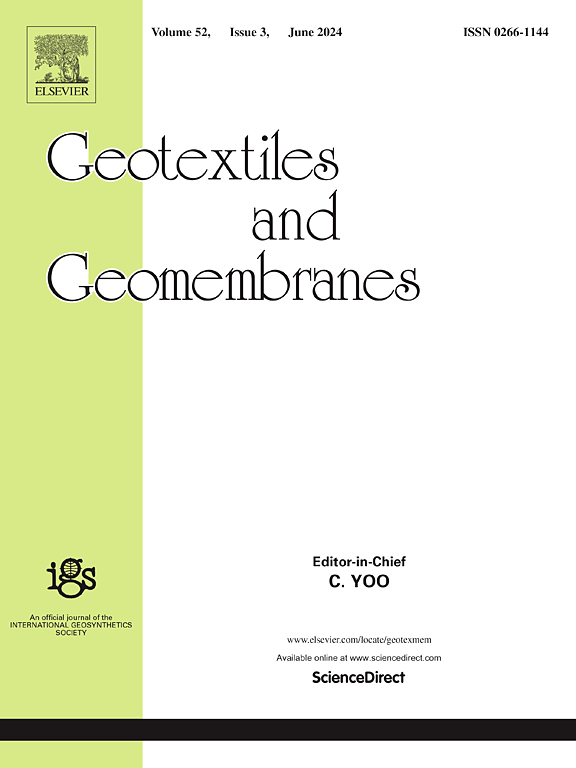A simple 3D orthotropic model for the tensile response of geogrids: In-isolation and soil–geogrid interaction applications
IF 6.2
1区 工程技术
Q1 ENGINEERING, GEOLOGICAL
引用次数: 0
Abstract
The short-term tensile response is one of the key aspects in designing geogrid-reinforced soil structures. In this paper a simple data-driven 3D orthotropic model for the short-term tensile response is proposed. The Hill48 yield model is chosen to represent the orthotropic behaviour of the geogrid, and a procedure to obtain the necessary parameters, from simple tensile test data, is presented. The model is then implemented in ABAQUS, and validated against a realistic problem where the geogrid is embedded in soil. The influence of the orthotropy (against isotropy) on both the reinforcement and the overall soil–geogrid structure is evaluated. The results show that the orthotropic model can accurately predict the tensile response of the geogrid in different directions, with the orthotropy having a significant influence on the reinforcement and the overall structural response, especially in highly orthotropic materials. The study further examined stress redistribution capabilities in geogrids with notches, revealing enhanced stabilization performance using the orthotropic model. Parametric tests indicated that traditional isotropic assumptions might underpredict or overpredict reinforcement performance, emphasizing the advantages for accurate orthotropic characterization. The proposed 3D framework provides a robust, straightforward method for evaluating and optimizing geogrid designs, enabling better prediction of reinforced soil behaviour in geotechnical applications.
土工格栅拉伸响应的简单三维正交各向异性模型:隔离和土-土工格栅相互作用的应用
短期拉伸响应是土工格栅加筋土结构设计的关键问题之一。本文提出了一种简单的数据驱动的三维正交各向异性短期拉伸响应模型。选择Hill48屈服模型来表示土工格栅的正交各向异性行为,并给出了从简单拉伸试验数据中获得必要参数的过程。然后在ABAQUS中实现该模型,并针对土工格栅嵌入土中的实际问题进行验证。评价了正交异性(相对于各向同性)对加固和整体土工格栅结构的影响。结果表明:正交各向异性模型能准确预测土工格栅在不同方向上的拉伸响应,且正交各向异性对配筋和整体结构响应有显著影响,特别是在高正交各向异性材料中。该研究进一步研究了带缺口的土工格栅的应力再分布能力,揭示了使用正交各向异性模型增强的稳定性能。参数测试表明,传统的各向同性假设可能会低估或高估钢筋性能,强调准确的正交各向异性表征的优势。提出的3D框架为评估和优化土工格栅设计提供了一种强大、直接的方法,能够更好地预测土工应用中的加筋土行为。
本文章由计算机程序翻译,如有差异,请以英文原文为准。
求助全文
约1分钟内获得全文
求助全文
来源期刊

Geotextiles and Geomembranes
地学-地球科学综合
CiteScore
9.50
自引率
21.20%
发文量
111
审稿时长
59 days
期刊介绍:
The range of products and their applications has expanded rapidly over the last decade with geotextiles and geomembranes being specified world wide. This rapid growth is paralleled by a virtual explosion of technology. Current reference books and even manufacturers' sponsored publications tend to date very quickly and the need for a vehicle to bring together and discuss the growing body of technology now available has become evident.
Geotextiles and Geomembranes fills this need and provides a forum for the dissemination of information amongst research workers, designers, users and manufacturers. By providing a growing fund of information the journal increases general awareness, prompts further research and assists in the establishment of international codes and regulations.
 求助内容:
求助内容: 应助结果提醒方式:
应助结果提醒方式:


